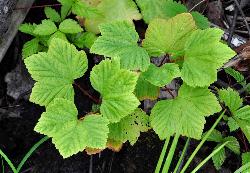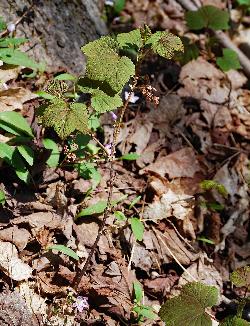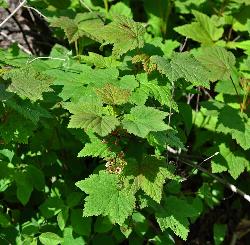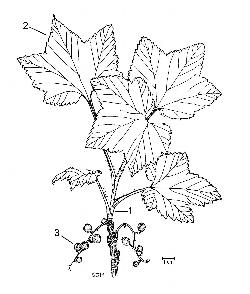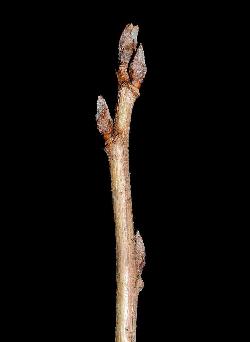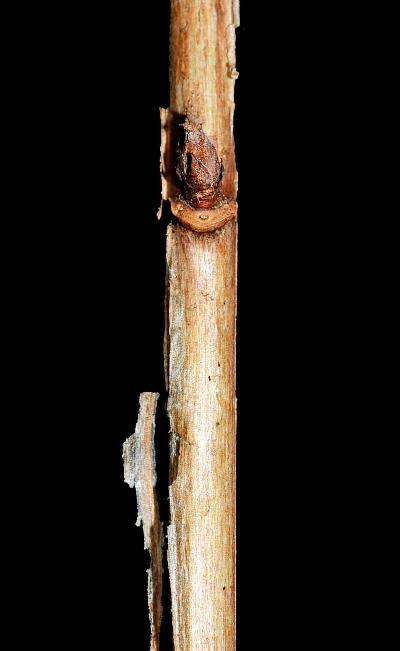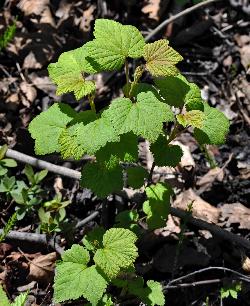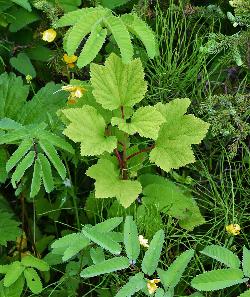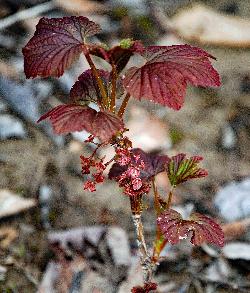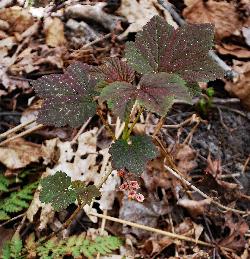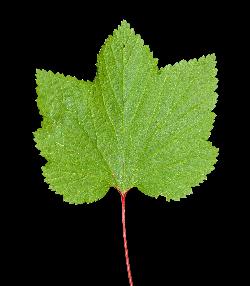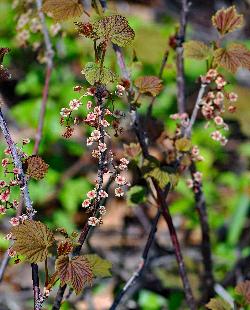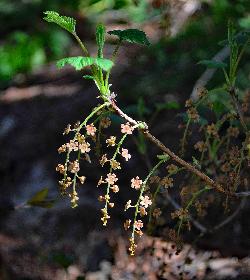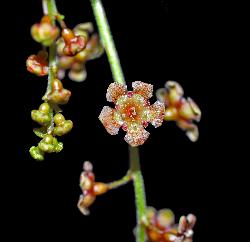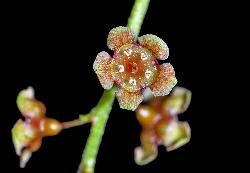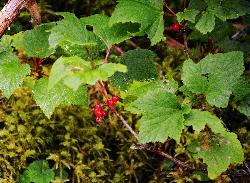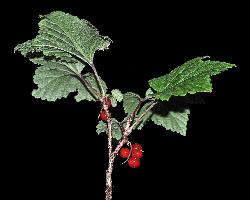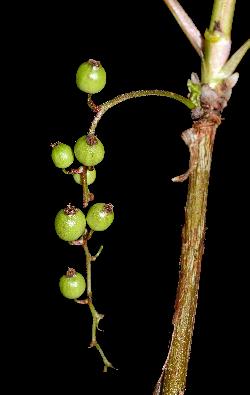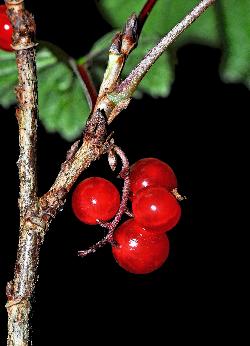Fr: gadellier amer, gadellier rouge sauvage
Grossulariaceae - Currant Family
Note: Numbers provided in square brackets in the text refer to the image presented above; image numbers are displayed to the lower left of each image.
General: An erect to spreading or prostrate deciduous shrub, to 1 m tall, with smooth (glabrous) unarmed stems and palmately-lobed leaves with reddish petioles [1]; lower stems often root at the nodes. Swamp red currant flowers begin to bloom as the leaves are expanding [2–3], its berries are sour, but edible, and provide food for a variety of birds and small mammals. All currant species, including bristly black currant, are alternate hosts for white pine blister rust (Cronartium ribicola F.C.Fisch.), a serious disease of Pinus strobus and other 5-needled pine species.
Key Features: (numbers 1–3 refer to the illustration [4])
1. Stems lack bristles and stipular spines.
2. Leaves are 3–5-lobed, divided less than half way to the midrib; the broad triangular lobes are widest at the base; margins are biserrate and the base is broadly cordate.
3. Mature berries are red, glabrous, and borne in drooping clusters on upturned pedicels.
Stems/twigs: Young green stems are slightly pubescent; woody twigs are glabrous, greyish-brown or light brown to purplish, dull, unarmed, and have decurrent lines extending down from both ends of leaf scars [5]; the bark is thin and shreddy [6]. Buds are alternate, dark brown, finely pubescent, lanceoloid, pointed, and have 7 or more imbricate bud scales. Leaf scars are hemispheric, broadly U-shaped, and have 3 bundle trace scars [7].
Leaves: Alternate, simple, palmately lobed and veined, and petiolate [8–9]; petioles are 3–6 cm long, often red [1, 9], slightly wider and grooved at the base, and finely pubescent with scattered stipitate-glandular hairs. Emerging leaves are deep reddish-purple to bronze in colour [10–11]; mature leaves are light green to dark green above and mainly glabrous [12–13]; the lower surface [14] is slightly paler and finely puberulent, but lacks glandular hairs. Leaf blades are 4–10 cm long by 5–10 cm wide and divided into 3–5 shallow lobes [12–14]. The upper 3 lobes are triangular and widest at the base; lower lobes, if present, are small and more rounded; sinuses between the upper lobes are broad, usually over 90° wide. Leaf bases are divergent to broadly and shallowly cordate, apices are acute. One unique feature of swamp red currant leaves is that the petiole splits into several palmate veins at the junction of the blade and petiole, with the outer margins of the petiole bordering the first few millimeters of the broadly cordate base [12–14].
Flowers: Bisexual, in pendant racemes, 2.5–7.5 cm long, with 6–13 flowers, and emerging from lateral buds on woody stems [15–17]; the axis of the inflorescence and pedicels are glabrous to slightly pubescent with short stipitate-glandular hairs. Flowers are less than 6 mm wide, borne on jointed pedicels 1–4 mm long, each subtended by an oblong to ovate bract, 1.5–2 mm long. Flowers have an open to shallow saucer-shaped hypanthium rimmed by the 5 petaloid calyx lobes, which are broadly obovate and pale green, pinkish, salmon-coloured, dark reddish-purple, or often somewhat speckled or mottled with green and brown [18–19]. The 5 very small petals are fan-shaped (flabelliform), deep red-violet, and alternate with the calyx lobes. The outer surfaces of the hypanthium and inferior ovary are glabrous; the inner surface of the hypanthium is flat and covered by a pale green to pinkish nectar disk [19]. The 5 stamens, situated at the edge of the disk, opposite the calyx lobes, are slightly longer than the perianth, have pinkish-red filaments, and whitish anthers. The ovary bears 2 styles, usually connate for more than half their length. Flowers bloom in early summer. All native Ribes species in our area can self-fertilize, but are also pollinated by insects, primarily bumblebees (Bombus spp.) and honeybees (Apis spp.), as well as other bees and flies (entomophily) (Bratsch and Williams 2009).
Fruit: In drooping clusters of glabrous globose red berries [20–21] (technically, a false berry derived from an inferior ovary), each 6–10 mm in diameter. Berries are green when immature [22] and translucent red at maturity [23]. The pedicels curve upward, thus the fruits have the persistent dried perianth at the top of the developing berry. Fruits dehisce at the joint of the pedicel, which is situated about halfway along the length of the pedicel. The fruit are edible, but tart. Dispersal is by a variety of mammals and birds, which eat the fruit (endozoochory).
Ecology and Habitat: Swamp red currant usually occurs in wet, nutrient-rich, open forests and sometimes along the edges of small streams in forests. It can recover quickly following fire and harvesting, but does not increase significantly in abundance in response to increased light.
Edaphic Grid: See image [24]: the Edaphic Grid for Ribes triste.
Forest Types: Swamp red currant is found with low frequency and abundance in the following forest types:
Abietum alnetosum (Alder-Balsam Fir Forest Subassociation)
Abietum rubetosum (Rubus-Balsam Fir Forest Subassociation)
Carici-Piceetum (Carex-Black Spruce Fen Association)
Osmundo-Piceetum (Osmunda-Black Spruce Fen Association)
Succession: Swamp red currant is shade-tolerant, but can also occur in open, early successional sites after fire and harvesting. The seeds are viable for long periods and can germinate after harvesting and fires that do not consume the organic horizon. Vegetative reproduction by sprouting from the root crown is also possible. In Newfoundland, swamp red currant always occurs with low frequency and abundance in forests and, although it can readily recover from disturbance, it rarely expands much in early seral succession.
Distribution: Ribes triste is native to north-temperate and boreal North America, as well as eastern Asia; it occurs throughout western Newfoundland, from the Codroy Valley north through the Great Northern Peninsula; it extends north only to southeastern Labrador (Scoggan 1978). Its range in North America extends from Newfoundland and Labrador west to Alaska, and is found in all Canadian Provinces. In the United States, it occurs from Maine across the northern Border States to Washington and Oregon, but is absent from Idaho, it also occurs sporadically in the east from Maine southeast to Virginia (USDA, NRCS 2016).
Similar Species: Currants and gooseberries are both classified as species of the same genus (Ribes), but currants have several flowers arranged in long racemes, their flowers are borne on jointed pedicels, and the hypanthium is open and saucer-shaped; gooseberries have 1–3 flowers borne on unjointed pedicels in leaf axils, and their flowers have a short tubular hypanthium. Skunk currant (Ribes glandulosum Grauer) is the only other native currant in our province that has red berries, but skunk currant berries are bristly and occur in spreading clusters. The leaves of skunk currant have a deeply cordate base, 5–7 lobes with more deeply divided teeth, and emit a skunk-like odour when crushed.


